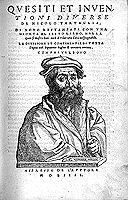 Fig. 11
Fig. 11  Fig. 12
Fig. 12

1. Niccolò Tartaglia, La nova scientia (first edition, 1537; this edition, Venice, 1558). Bound with his Quesiti et inventioni diverse (first edition, 1546; this edition, Venice, 1554).
Few European mathematicians of the 16th century had been as directly affected by war as Niccolò Tartaglia. In 1512, when still a boy, he received a facial wound during the sack of Brescia by the French. Left with a speech defect he adopted the nickname of Tartaglia ('stammerer') to replace his original surname Fontana.
If Tartaglia's very identity was marked by war, he in turn reshaped the character of military discourse by identifying a 'new science' of artillery and casting it as a mathematical discipline. As a mathematician he was first directed to military questions in 1531 or 1532 in Verona when he was consulted on the maximum range of cannon. Following up this initial query he subsequently published what was proudly announced as his Nova scientia of 1537. Tartaglia offered a general account of the fall of heavy bodies and a specific consideration of the path of artillery shot. His novel mix of natural philosophy and mathematics heralded the wider significance that falling bodies would soon have in European intellectual culture through the work of Galileo. But Tartaglia also showed how to measure the elevation of an artillery piece using a gunner's quadrant, and provided a discussion of surveying for range-finding.
After La nova scientia, Tartaglia returned to military matters in the Quesiti et inventioni diverse (1546), further discussing topics such as the shape of a projectile's trajectory. Although he qualified the theoretical accuracy of his depiction, for practical purposes Tartaglia consistently described the path of the shot in three parts: an initial straight line propelled by the force of the gunpowder; a curving section as gravity began to work its effect; and finally a straight line again as the shot fell perpendicularly to the ground. A measure of Tartaglia's importance for the study of artillery is that this account was still being paraphrased and parroted into the later 17th century. But he did not provide later authors with all they could have wished. In both the Nova scientia and the Quesiti et inventioni diverse he promised tables of 'randons' (ranges achieved at different elevations), but these were never forthcoming.